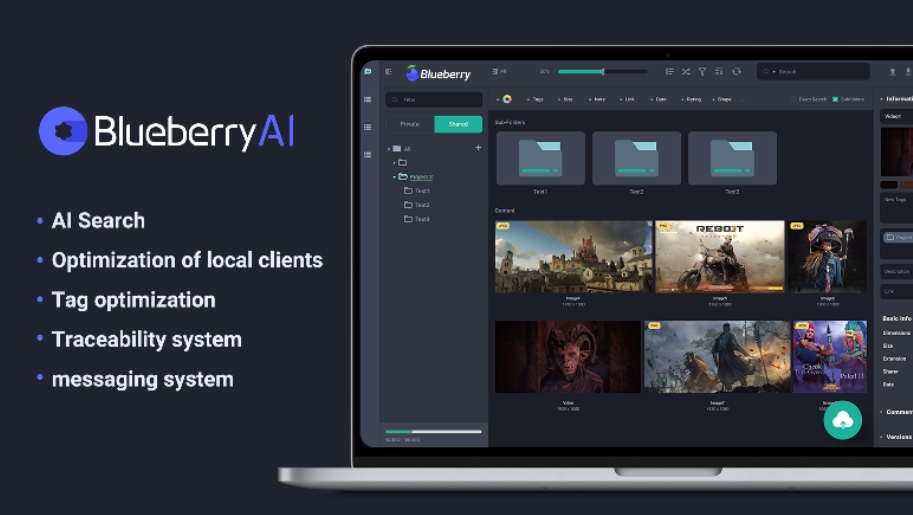Diving into the world of AI can feel overwhelming, but working with the Blueberry AI model doesn’t have to be. Whether you’re a complete beginner or just curious about how to get started, this guide will walk you through the basics in a simple and approachable way.
What is Blueberry AI?
Blueberry AI is a cutting-edge Digital Asset Management (DAM) solution that simplifies 3D asset organization and collaboration. It offers browser-based 3D previews, AI-powered search and tagging for quick asset discovery, and secure sharing tools to streamline workflows and enhance efficiency.
When I first used Blueberry AI, I was impressed by its intuitive interface, making 3D asset management straightforward, even for non-technical users. Its features focus on optimizing digital workflows, including:
- 3D Asset Previews: View and collaborate on 3D files directly in your browser.
- AI-Powered Search: Quickly locate assets with intelligent tagging and filtering.
- Streamlined Sharing: Securely share digital assets for seamless collaboration.
These capabilities simplify complex asset management and boost productivity.
Key Features of Blueberry AI
Digital Asset Management Capabilities
Blueberry AI manages existing digital assets, making organization and collaboration seamless. Its advanced tools enable users to preview, search, and tag 3D assets efficiently, ensuring quick access and optimal resource utilization. For instance, users can filter assets by type, format, or usage, streamlining workflows for creative or technical projects.
This platform supports various 3D file formats, allowing teams to collaborate without additional software. Blueberry AI empowers professionals to enhance productivity and reduce manual effort in asset handling by focusing on managing and optimizing existing resources.
Getting Started with Blueberry AI
Getting familiar with the Blueberry AI model involves straightforward steps that help simplify its advanced capabilities. Because of its intuitive design, the initial setup and usage feel smooth, even for beginners.
Accessing the Model
Start by creating an account on the Blueberry AI platform. After signing up, log in to access the dashboard, which neatly organizes various tools. The dashboard is your central hub for managing tasks and exploring the AI’s functionalities.
If you’re like me and often forget passwords, the platform supports secure, quick password recovery. This made my setup less stressful and got me to try its features.
Basic Usage Instructions
Once inside, experiment with the preset templates available in the dashboard. Select a task, such as text generation or image creation. Input the required details, such as keywords and tone preferences, then click “Generate.”
I discovered that tweaking small settings like formality levels significantly impacts output quality. For instance, choosing a conversational tone instantly improved my drafts for casual audiences. Small adjustments can yield noticeable differences.
Technical Specifications
The Blueberry AI model integrates advanced frameworks to simplify tasks for beginners while maintaining high efficiency.
Architecture and Algorithms
The Blueberry AI model relies on transformer-based architecture, utilizing multiple attention layers to process data efficiently. Its machine-learning backbone supports supervised and unsupervised training, automating workflows precisely.
The platform’s architecture is designed to provide practical tools for efficient digital asset management. Its intelligent features include AI-powered tagging, advanced search capabilities, and various 3D file formats support. These tools simplify organizing, locating, and sharing assets, ensuring streamlined workflows.
Blueberry AI also incorporates secure asset sharing and browser-based 3D previews, enabling teams to collaborate effectively without additional software. This focus on practicality and efficiency makes it an invaluable resource for easily managing digital assets.
Enhancing Efficiency with Intelligent Tools
Optimizing digital asset management with the right tools reduces waste and improves productivity. Intelligent systems streamline workflows and minimize unnecessary costs.
Collaboration Features
Centralized tools like the Kiwi Engine of Blueberry AI simplify teamwork by giving everyone equal access to updated resources. I once managed a project where inconsistent permissions delayed deliverables by days. After transitioning to a shared digital platform with real-time updates and clear roles, project turnaround improved by 40%. Features like shared folders, version histories, and user-specific access levels reduce confusion, eliminate duplicated work, and help teams align on outputs.
Integration with Other Systems
Seamless integration across platforms keeps data consistent and actionable. Linking asset management tools with existing software, like project management or CRM, avoids manual data transfers. For example, integrating an AI-powered DAM system with task managers eliminates repetitive uploads while syncing deadlines and related files. This connection reduces manual errors and allows key systems to operate more cohesively, saving time and money.
Dynamic Asset Management Solutions
AI-powered tools adjust workflows to match immediate needs, improving asset utilization. For instance, automated tagging identifies content categories, while predictive algorithms suggest what content to prioritize. Tools like object-recognition software can sort assets into folders without manual intervention. These dynamic functions handle repetitive yet complex tasks, freeing teams to focus on creative or strategic priorities instead of organizing resources.
Conclusion
Using the Blueberry AI model for the first time, I quickly saw how its clear structure saved time on text generation tasks. Small adjustments in its settings led to noticeably better results. Explore its intuitive design, preset templates, and community support to grow your skills quickly.






























